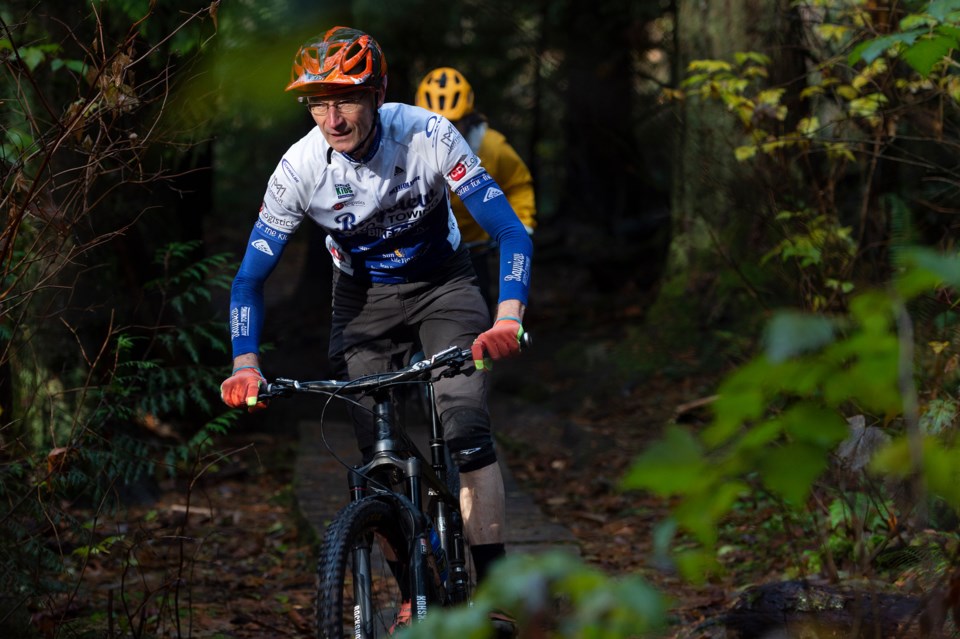For the final part of our series, Jammed Gears, we discover how mountain biking trails were decommissioned – a move that was quickly reversed by the city after pushback from the local mountain biking community.
And we look at the efforts being made to mend a broken relationship.
To find the full index of stories in this series, see our Jammed Gears landing page.
Dave Ellenwood has a friend who remembers when biking on Burnaby Mountain was a less refined sport, a sign of how far things have come in the last half-century.
“As a kid they used to take the trails. They used to put construction helmets on and strap flashlights to them and go down the trails at night on their mountain bikes when he was a kid,” Ellenwood, the City of Burnaby’s parks, culture and recreation director, told the NOW in January with a laugh.
“That’s – not to mention exceedingly dangerous – that’s decades ago, probably 40, 50 years ago.”
A lot has changed since then. For one, the city now has a plan, inked in 1999, that guides management of the mountain. And beyond that, the city has also entered into an agreement with the mountain biking community. In 2005, the Burnaby Mountain Biking Association formed to coordinate trail maintenance with the municipal government.
While mountain biking long predates Ellenwood’s time with the parks department, his tenure in senior management in parks – about 18 years – runs a bit longer than the city’s agreement with the mountain biking association.
“The relationship (between the city and mountain bikers) is good, I hope. … I have been biking on the mountain with Ron Burton, who was the longtime president of that association. And Ron, of course, is very close to our council as being the (former) school board chair,” Ellenwood says.
“So we’ve had a close relationship, and I think it’s been productive at times, and of course there’s been conflict at other times. … Generally, I think their interests are recognized as one of the major uses of the mountain. So if we don't have a close relationship with them, then I consider that something that needs to be fixed.”
A wrong turn
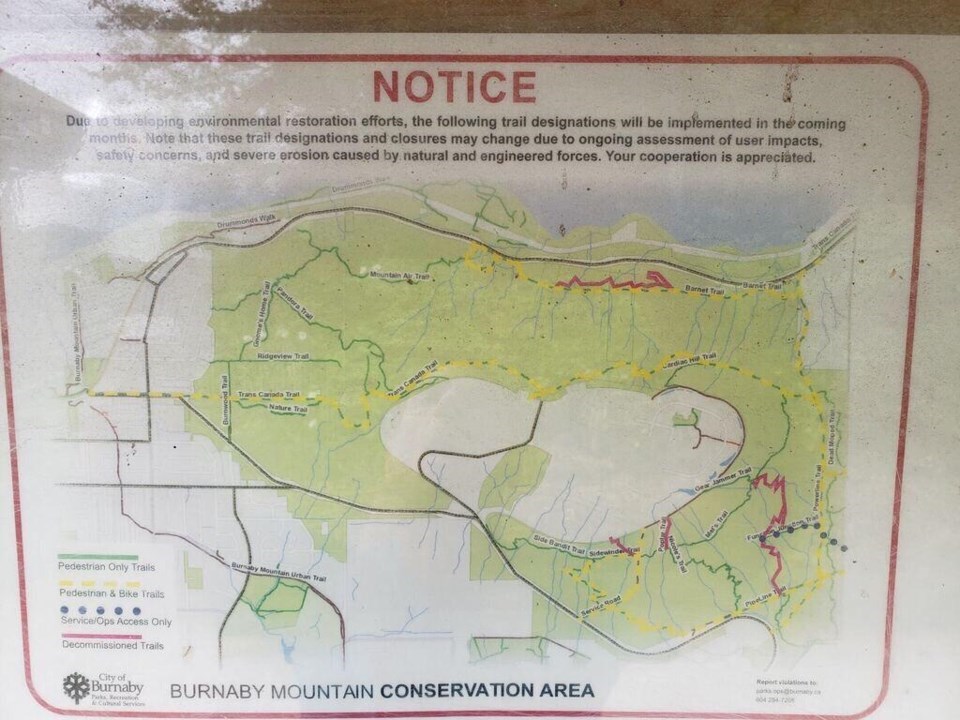 This sign, noticed by mountain bikers on Wednesday, caused alarm for Burnaby Mountain riders after it appeared to indicate the closure of downhill mountain biking trails. Submitted photo
This sign, noticed by mountain bikers on Wednesday, caused alarm for Burnaby Mountain riders after it appeared to indicate the closure of downhill mountain biking trails. Submitted photoOn July 22, city staff put up new maps on Burnaby Mountain, signalling the closure of downhill mountain biking trails, a move that has since been reversed..
The staff involved in the move expected the backlash – apparently without their boss’s knowledge.
“And it starts,” wrote superintendent of parks operations John Callaghan to other parks staff on July 23, as emails opposing the changes began rolling in.
Internal emails, obtained by the NOW through a freedom-of-information request, show parks officials intended to close the trails, but they didn’t have the approval of their department director or city council.
When local radio station News 1130 contacted the city for comment on the new maps that indicated the downhill biking trails were being decommissioned, Ellenwood confirmed to the city’s communications department that the new signs had not been approved.
“I have not authorized any decommissioning, nor has parks commission or council. We will have to see the results of our assessment before any changes can be considered to the trail network,” Ellenwood responds, later adding: “It is true that council, commission and I did not see the signage before it was posted.”
But inside Ellenwood’s own department, staff had been bracing for the pushback.
“Really looking forward to the feedback here. It may be a bumpy ride to start, however, the more that we get the word out regarding the city’s efforts regarding the conservation area, it should swing in our favour,” reads a July 10 email from Steve Bruneau, assistant director of parks, to Vince Reda, a parks designer and project manager with the city.
There are hints in the internal emails within the parks department that indicate the point of contention – the balancing of conservation and recreation.
Rick Sporns, assistant manager of parks design, points to “an entire industry of bike shops around Burnaby Mountain.”
“I couldn’t help thinking, what better proof how much things have gotten totally out of control as far as mountain biking taking over what should be a balanced conservation area,”Sporns says in a July 24 email to Reda. “Some of the complaint talking points may provide a lot of insight.”
In an interview with the NOW, Ellenwood says he doesn’t want to throw his staff under the tires, but he acknowledges the error made in his department regarding the trail decommissioning signs.
“We had one piece of information. We posted a sign that said, ‘Well, this is what we are thinking of doing,’ and that generated quite an understandable and vigorous reaction,” Ellenwood says. “My reaction was to say, ‘OK, I don’t think that was a great idea to have done that, and we’re going to say that to people.’ And that’s how it happened, and staff got the message.”
Eroding trails
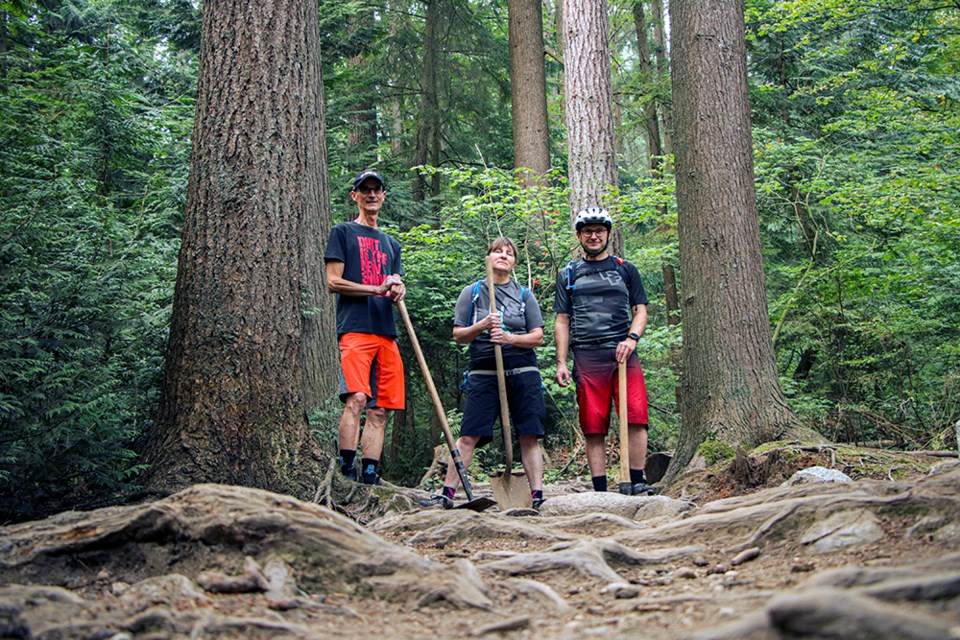 Burnaby Mountain Biking Association president Judy Garren is flanked by volunteers Brian Berg (left) and Brent Wilson with tools of their trade – maintaining the mountain's trails – in hand. By Dustin Godfrey/Burnaby Now
Burnaby Mountain Biking Association president Judy Garren is flanked by volunteers Brian Berg (left) and Brent Wilson with tools of their trade – maintaining the mountain's trails – in hand. By Dustin Godfrey/Burnaby NowIn their deluge of emails to the city over the reversed trail decommissioning, many bikers indicate they believe the issue of erosion is being unfairly pinned on them.
In fact, the mountain biking community typically takes the lead on dealing with erosion.
Each year, since 2005, the Burnaby Mountain Biking Association has submitted a list, to be approved by the city, of things for volunteers to work on – landscaping to redirect water flow here, bolstering the trail to better handle users there, repairing erosion on various trails.
The association details where volunteers would be working on each of the four trail days per year and what they would be working on. The city currently permits mountain bikers to work on trails for four days per year. More than a dozen volunteers show up, tools in hand, to do the necessary work, while materials – such as wood to build features or bolster a trail – are provided by the city.
But Burnaby Mountain Biking Association president Judy Garren says four days aren’t enough to get everything done – and the city has, until recently, shown no sign of budging on the number of trail days it offers mountain bikers.
“We’ve asked for more. At our previous (parks) commission presentation, we asked for more trail days, citing (water) drainage and erosion issues and all the work that had to be done, except we can’t get much done with only four days of seven hours,” Garren says. “We’re told categorically no.”
By comparison, the Tri-Cities association gets trail days about once a month, and the North Shore group was working on trails multiple times per week before the pandemic. (Both associations also have more trails to work on than the Burnaby group.)
“The need for more trail maintenance is paramount,” Garren says. “It’s pretty bad. And that can be easily taken care of.”
Ideally, for the mountain bikers, some of that trail work would include creating parallel trails to separate mountain bikers from other trail users, like hikers and runners, to avoid the other problem the cycling community feels has been pinned on them: conflicts between user groups.
Perhaps more importantly, however, Garren says her group wants two trail days a month from March to September or October – not including July and August when the soil is dry and less malleable – for a total of 10 days.
Not surprised
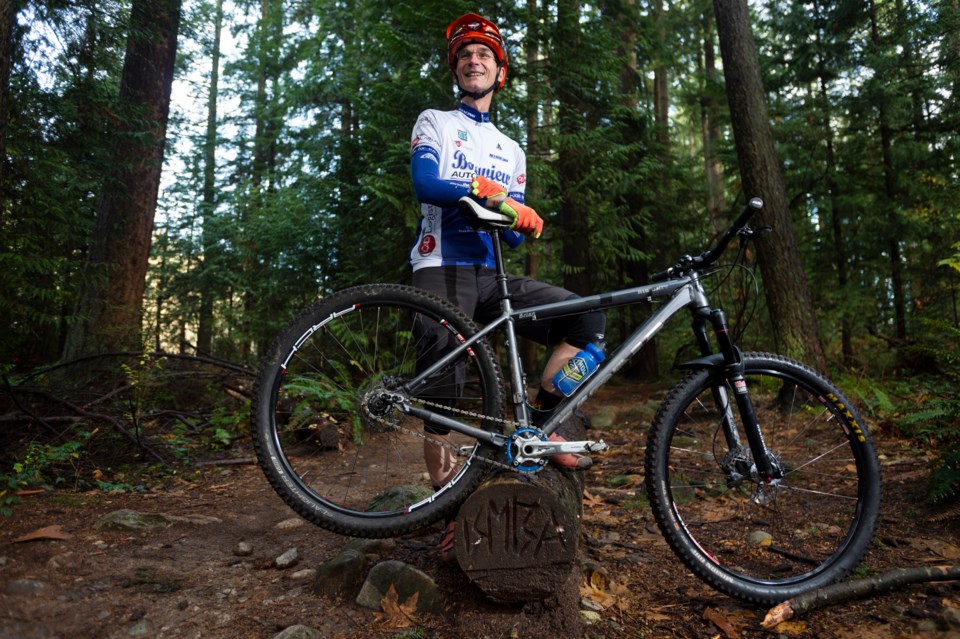 Brian Berg, a mountain biker and volunteer with the Burnaby Mountain Biking Association, leans on a log carved with the club's initials. Photo: Jennifer Gauthier/Burnaby Now
Brian Berg, a mountain biker and volunteer with the Burnaby Mountain Biking Association, leans on a log carved with the club's initials. Photo: Jennifer Gauthier/Burnaby NowThe mountain bikers’ request isn’t new. Garren says she and the mountain biking association have been asking for more trail days for years, but they feel that request has gone unheard in the city.
Ellenwood says that doesn’t surprise him.
“You could argue that they’re not doing their job properly if they’re ever satisfied with the level of infrastructure that’s on there. They’re always striving for more,” he says.
Pushing for more, Ellenwood says, is the sign of a healthy level of interest from the group, which is intended to advocate for ever-greater infrastructure for the people it represents.
“At the same time, with the balance we have to achieve and the resources we have at our disposal, sometimes that objective, from their perspective, can’t be met by us,” Ellenwood says. “We do want to address (that).”
But he says it’s more complicated an issue that will take some time to implement.
“It’s not a matter of making a phone call to increase trail days,” he says.
Trail days require several staffers with the city to be present, supervising and assisting with the work, which means the city needs to look at its staffing and fit several more seven-hour days of work into its schedule for each trail day.
That’s not to say the city hasn’t looked at adding more trail days in the past. Ellenwood points to a now-retired staffer, Henry De Jong, who previously organized trail days and who “expressed some frustrations on both sides of the spectrum.” Ellenwood says De Jong was frustrated when trying to get the necessary staff in place or to even earmark his own time for the trail days.
Mending the relationship
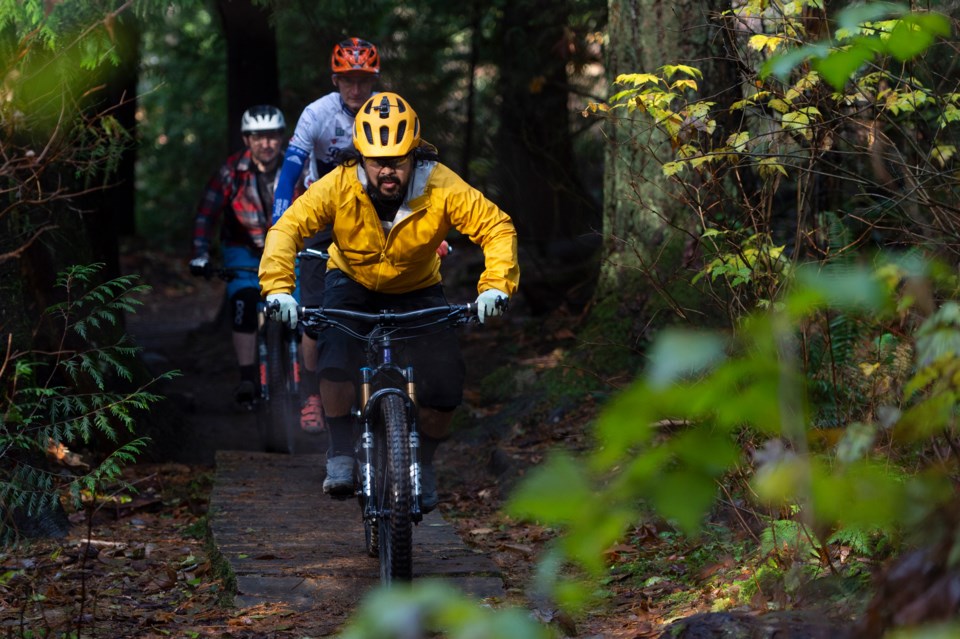 Karno Splinter, Brian Berg, and Brent Wilson are mountain bikers and volunteers with the Burnaby Mountain Biking Association. Photo: Jennifer Gauthier/Burnaby Now
Karno Splinter, Brian Berg, and Brent Wilson are mountain bikers and volunteers with the Burnaby Mountain Biking Association. Photo: Jennifer Gauthier/Burnaby NowMountain bikers presented to the parks, recreation and culture commission in September, seeking a “champion” to represent cycling issues, but Garren says it didn’t go so well. The group left without any indication the city was prepared to work with them – in fact, quite the opposite.
“I’ve been wondering if we even have a relationship with the city, given how dismissive the chair was of our organization,” Garren said in an email shortly after the meeting.
But Mayor Mike Hurley notes a discrepancy between how the mountain bikers have seen their conversations and how the city has seen them.
“There seems to be some frustration on their part about how much they were allowed to be part of making new trails on the mountain and repairing trails and keeping trails and … looking after the environment up there,” Hurley says.
“From our side, we felt that that door was always open.”
Hurley told the NOW in October, before his meeting with mountain bikers, that his understanding was that mountain bikers and the city were coming to an agreement to do more work on the mountain, including up to one trail day per month.
But an increase in trail days came as news to Garren when the NOW asked her about Hurley’s comments, raising questions about communication between the city and the mountain bikers.
“We have had zero discussion with the city since our last presentation to the parks commission in September,” Garren said in October.
Despite seeing firsthand the frustrations from the mountain bikers, Hurley retains his optimism, calling the November meeting a “good meeting” but noting more work needs to be done.
Indeed, while there appears to be an agreement on 10 trail days a year, Garren says a few issues still need ironing out, including when to hold the trail days.
Garren calls the November meeting’s results “promising,” but she’s less optimistic than Hurley, still skeptical of the city’s intentions and whether it will hold up to the offer of 10 trail days a year.
“However, I am doing my best to remain optimistic,” she said late last year.
Ellenwood says he has directed his staff to get in touch with Garren to plan the trail days for the year, including scheduling the days and determining the number of volunteers and staff needed.
But despite that, as of late February, Garren says there still has been no contact at all from the department since the November meeting, which she said is “not surprising but very disappointing.”
“Our group is in limbo (and under constant criticism from the general public). It’s really frustrating not being able to provide concrete info to people,” Garren wrote. “The pandemic isn’t going anywhere, and I’ve heard the trails are continuing to deteriorate.”
This has been the final part of our series. Thank you for reading.
To find the full index of stories in this series, see our Jammed Gears landing page.
Find Dustin Godfrey on Twitter at @dustinrgodfrey
